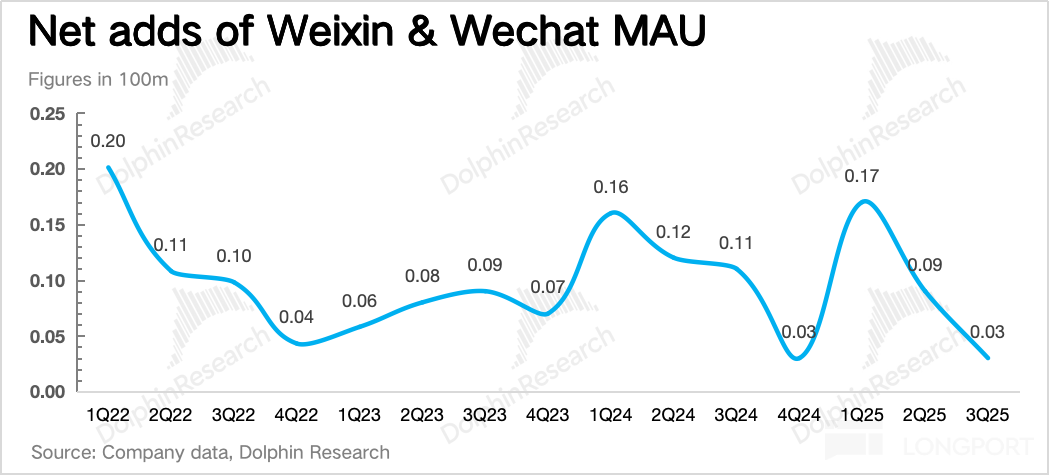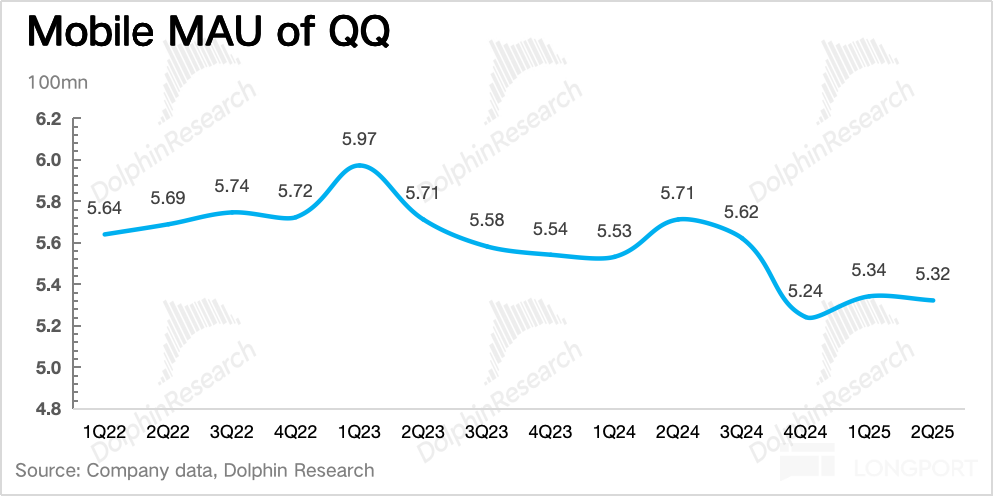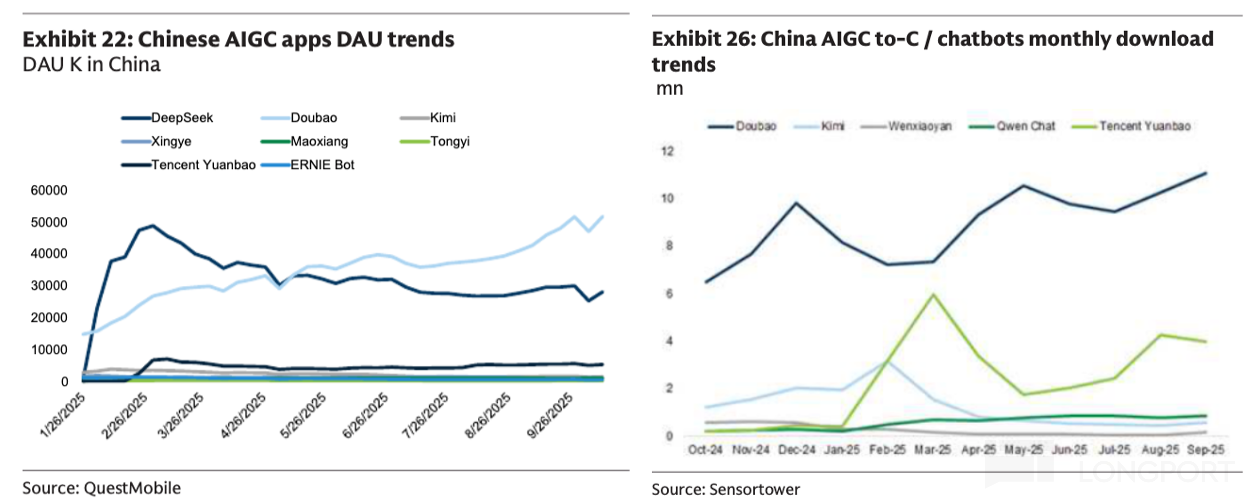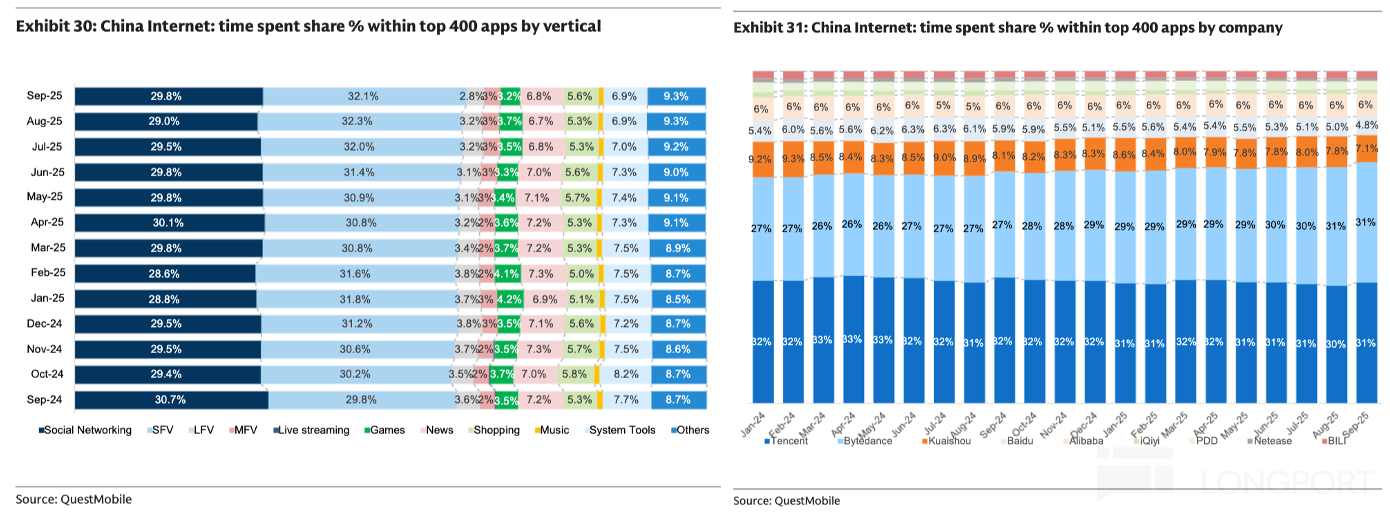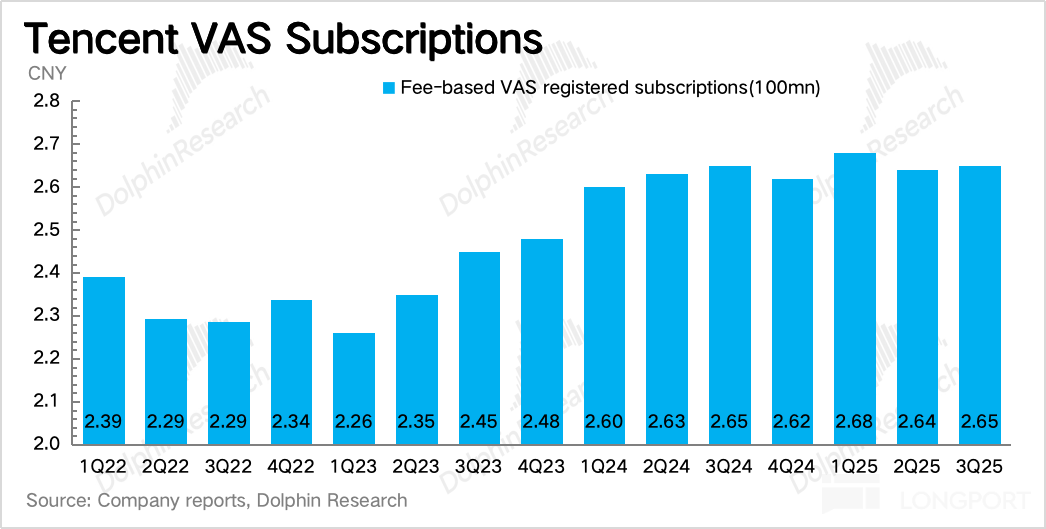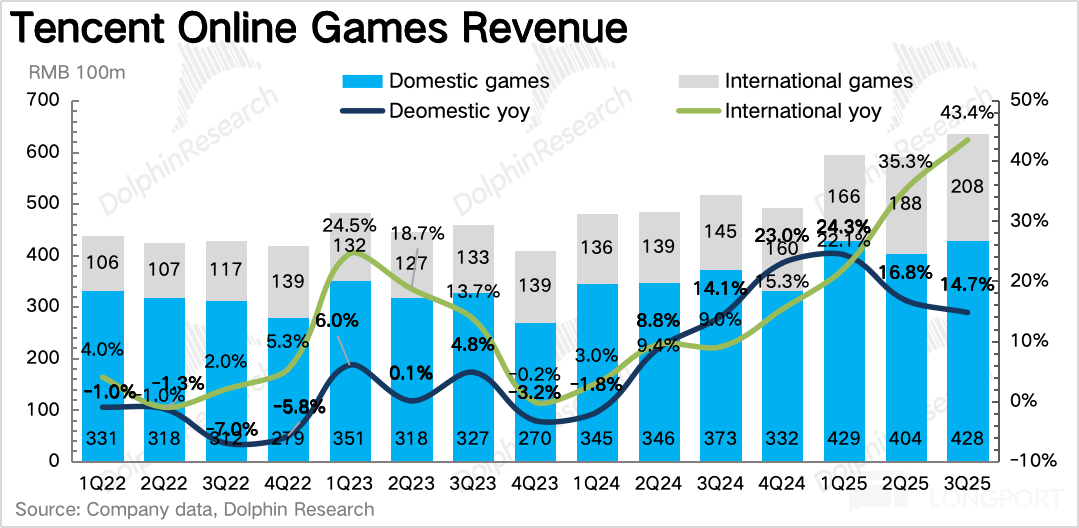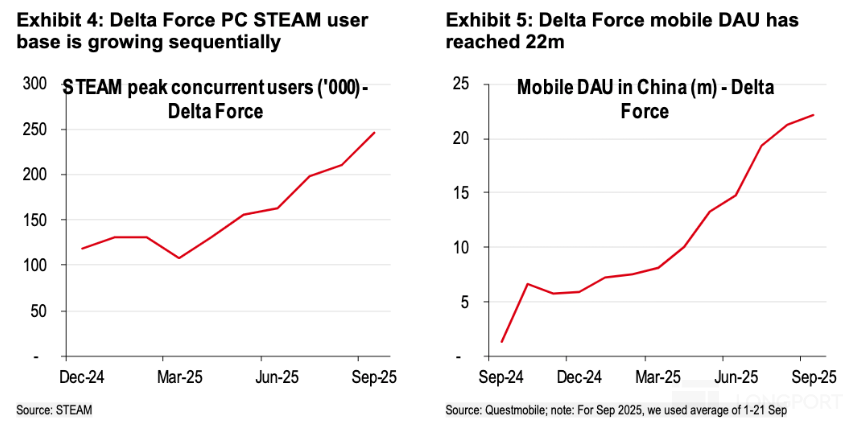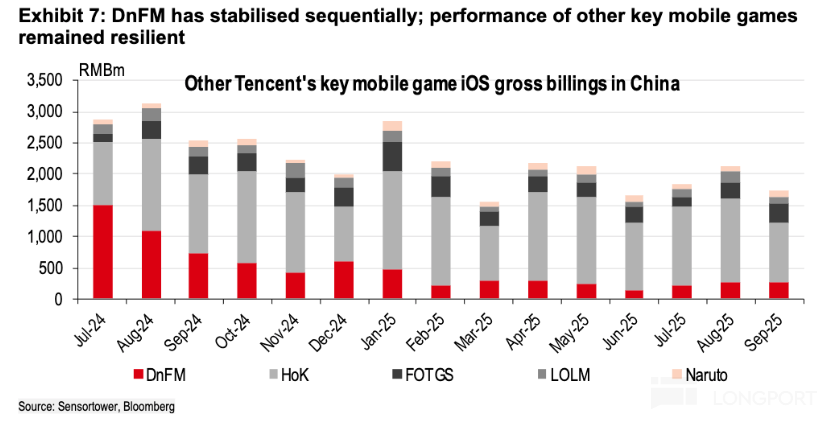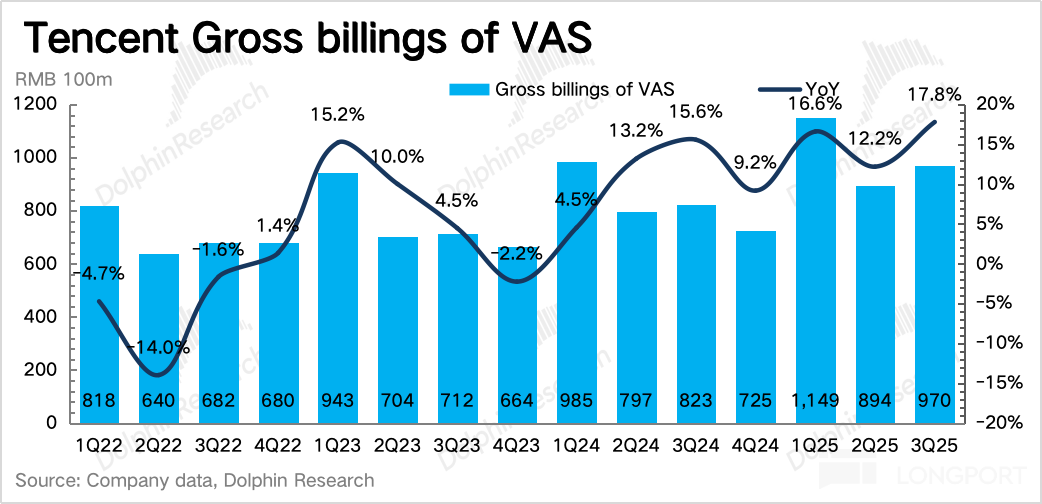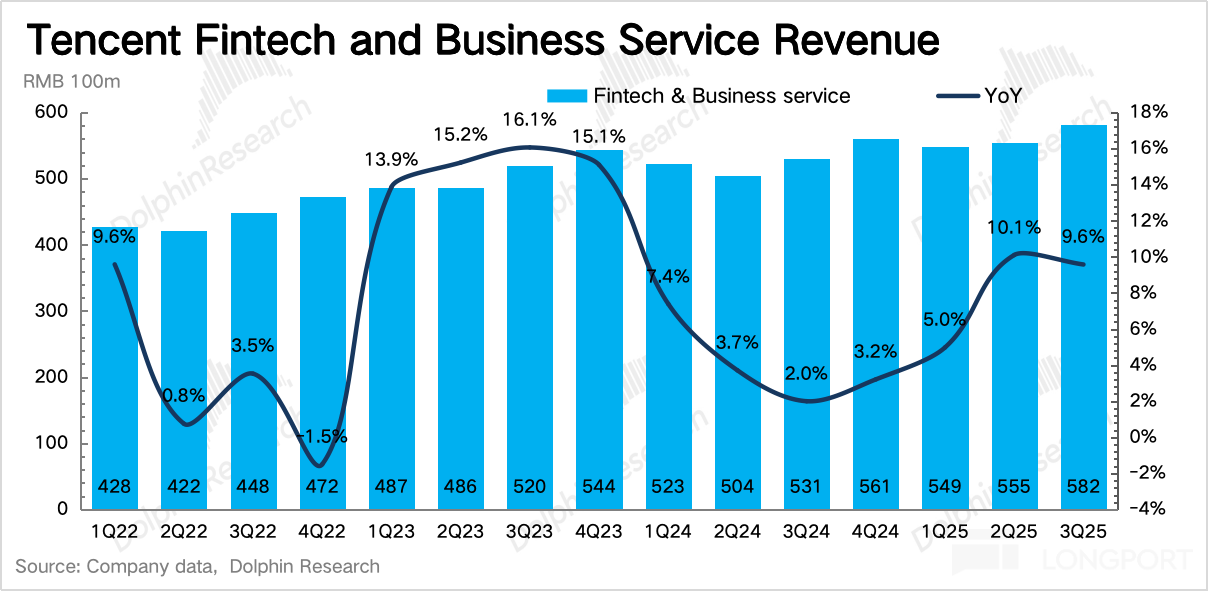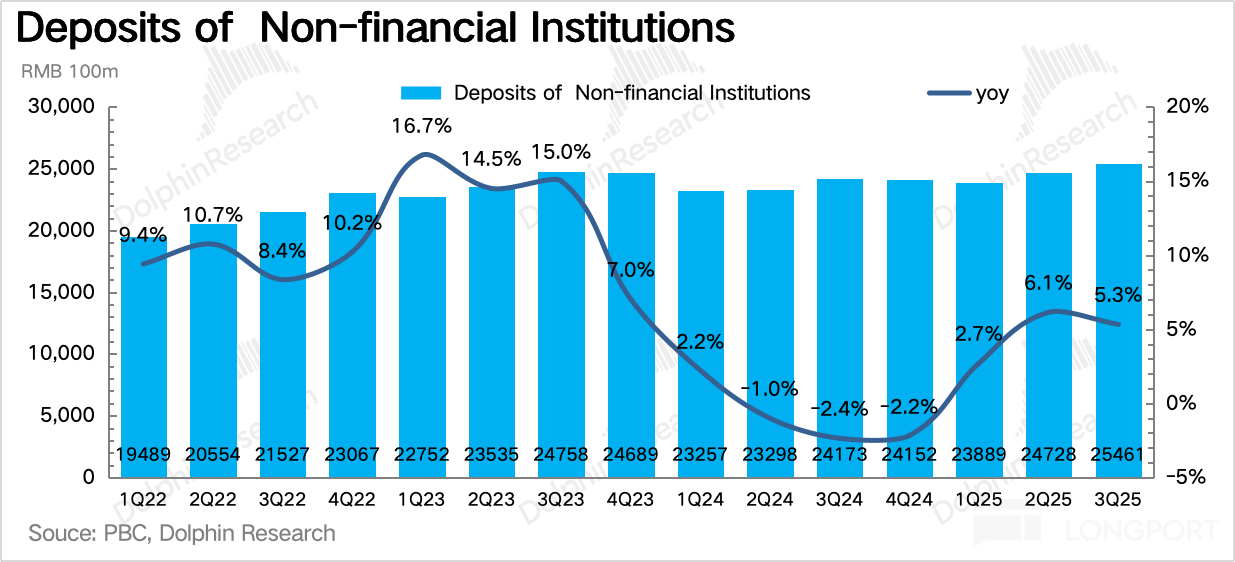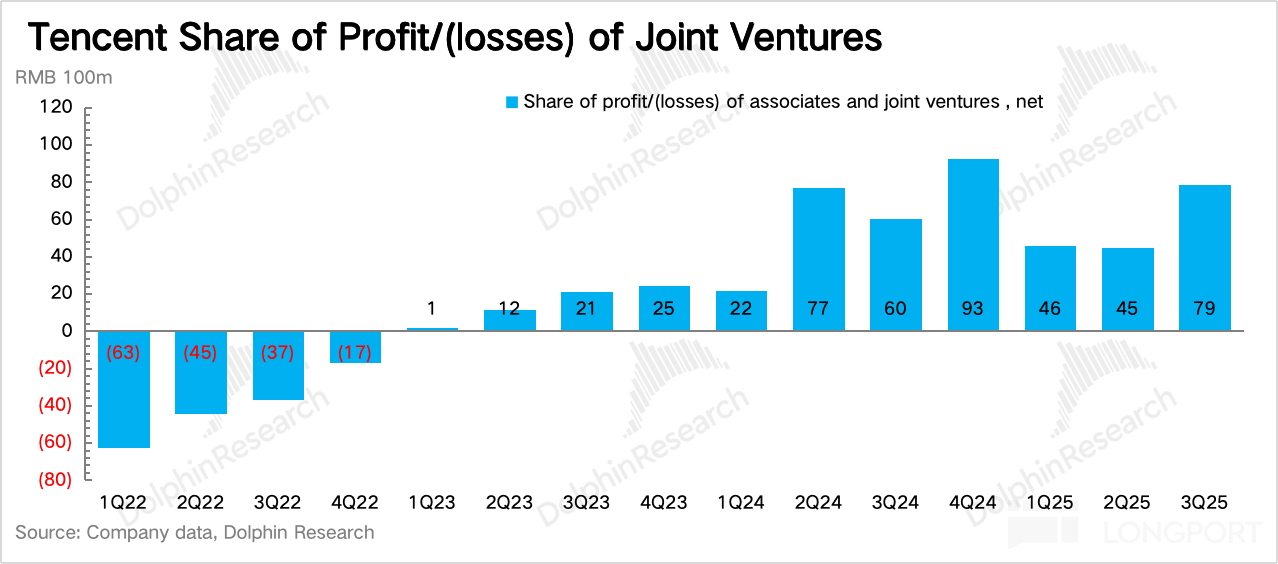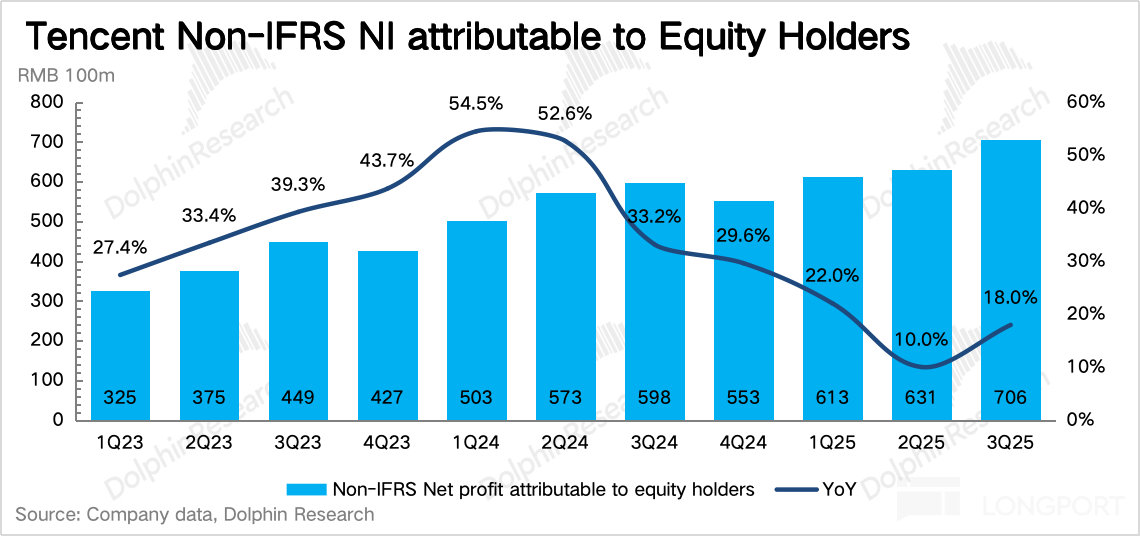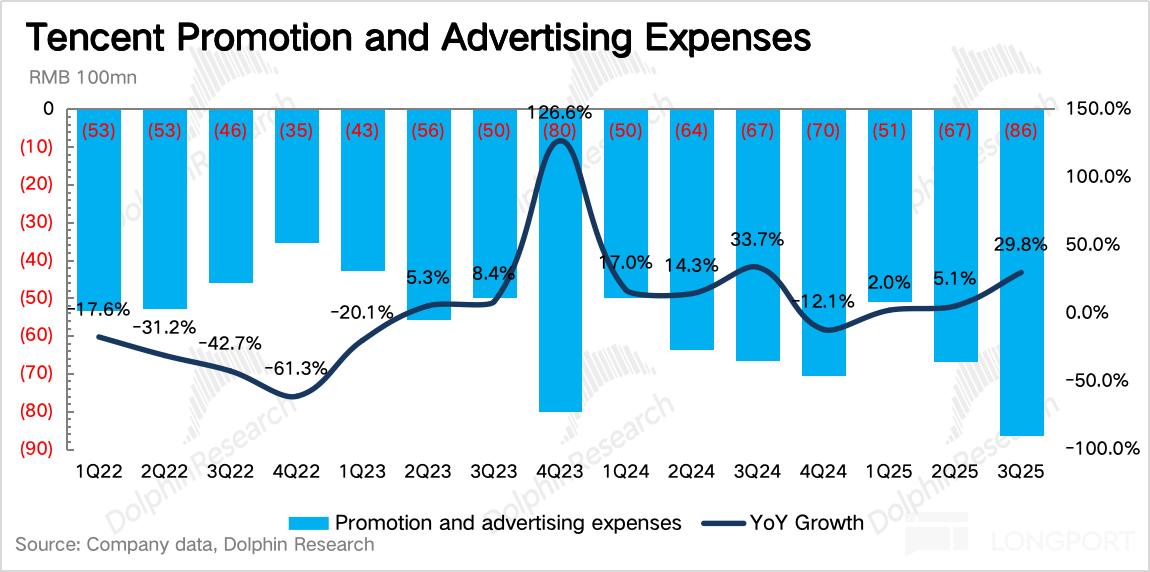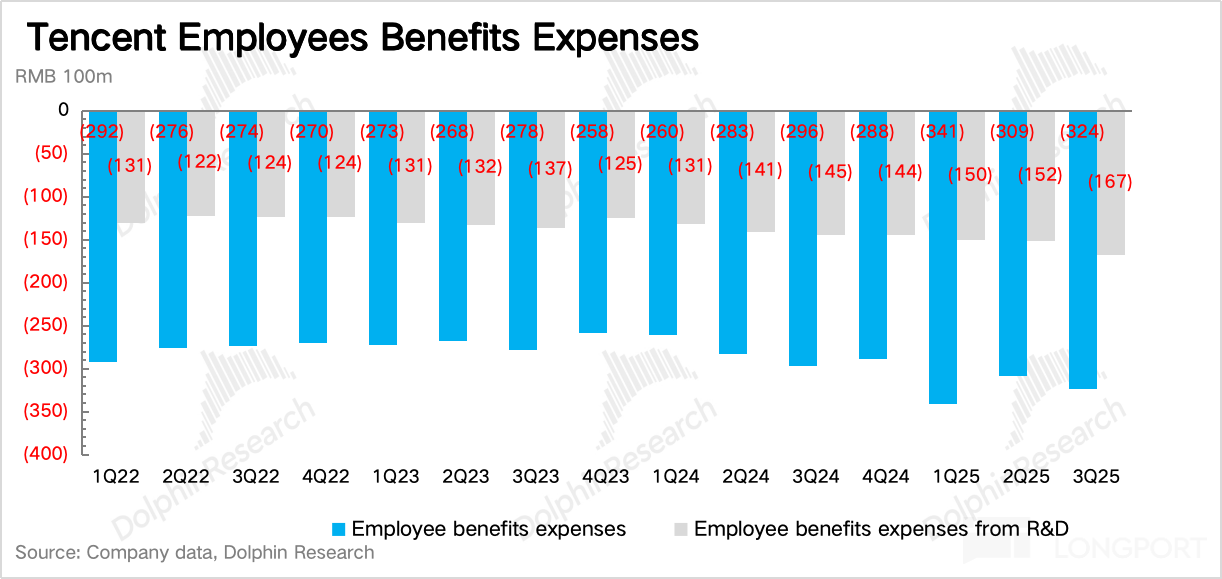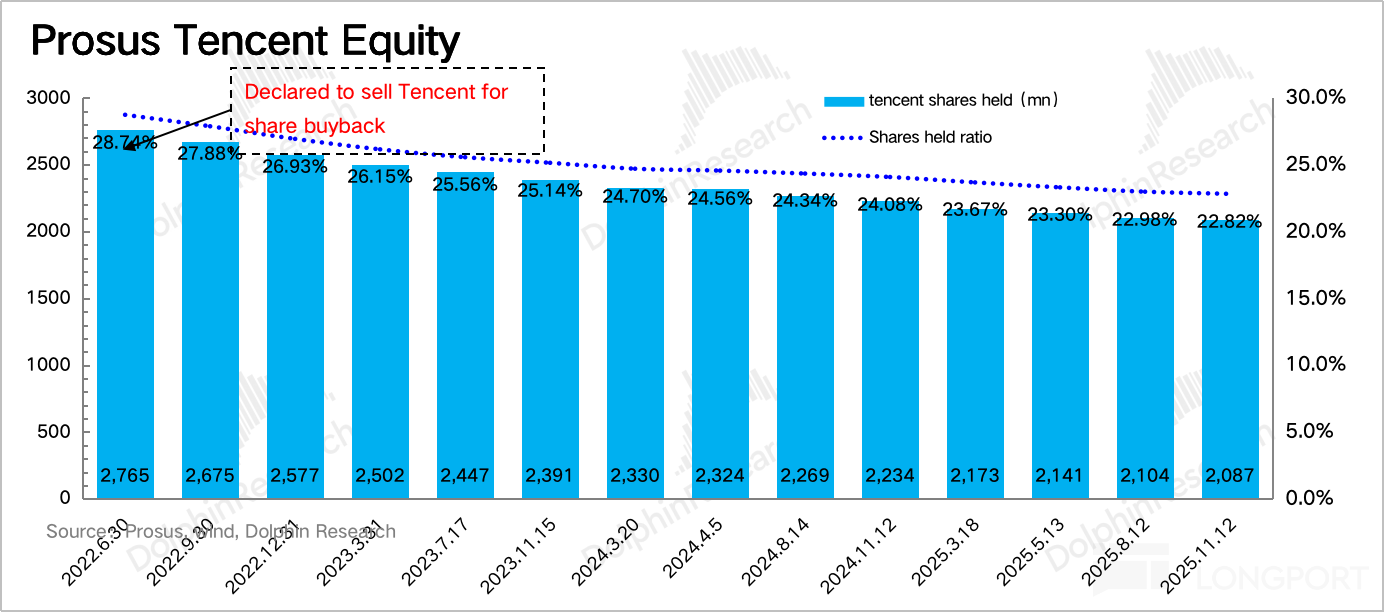
Tencent: Not playing heartbeats with Meta, just seeking stable happiness

After the Hong Kong stock market closed on November 13, Beijing time, $TENCENT(00700.HK) released its third-quarter 2025 results. Overall, while there were not many surprises compared to expectations, stability remained the key theme, with no significant weaknesses in the three major business lines. Since the beginning of this year, Tencent has entered a new investment cycle, but traces of the management's refined operations and effective capital allocation can still be seen.
Specifically:
1. Gaming remains the brightest star: Tencent's gaming segment maintained a high growth rate of 23% in the third quarter, driven by the product cycle. Overseas, led by Supercell's 'Clash Royale', continued to surge (with favorable exchange rate contributions), while domestic growth, although slowing quarter-on-quarter, still achieved a 14% increase on last year's high base of 'DnFm', which is impressive. The main drivers were PC games like 'Delta Game', mobile games like 'Valorant', and evergreen games like 'Honor of Kings' and 'Peacekeeper Elite'. From deferred revenue, Q3 saw a quarter-on-quarter increase, reflecting the sustainability of the current high revenue streams.
2. Advertising remains strong and steady: Advertising grew by 21% in Q3, with a slight acceleration quarter-on-quarter, mainly driven by increased ad load rates and AI's enhancement of ROI (with the launch of the intelligent delivery product AIM+, improving ad targeting and driving eCPM growth). In terms of specific ad types, it is speculated that the main contributions came from video accounts, search, and mini-programs. Looking back, Tencent has maintained a strong growth trend of over 15% each quarter for two consecutive years.
3. Fintech rebounds with wealth business: The combined revenue growth of fintech and enterprise services approached 10%, in line with expectations, with fintech achieving high single-digit growth, mainly benefiting from stable payment recovery and consumer loans. Enterprise services, primarily cloud-based, grew by 10-20% year-on-year due to AI demand, which is not high, and also includes commission fees from WeChat stores. Dolphin Research speculates that the main reason is the strategic requirement to prioritize internal supply of computing resources.
4. Gross margin remains stable: The group's gross margin increased by more than 1 percentage point year-on-year, with a slight decline quarter-on-quarter. High-margin businesses such as self-developed games, video accounts, and search offset the low-margin cloud business, while ongoing AI investments have also begun to increase in depreciation and amortization (accelerating year-on-year growth by 23%, with a 0.5 percentage point increase in revenue share).
5. Increased expense investment: Operating expenses continued to accelerate, growing by 19% in Q3, with the majority coming from R&D expenses, including significant increases in R&D personnel salaries and benefits, and server costs. Additionally, promotional expenses in sales costs, possibly related to the promotion of Yuanbao, the public testing of two major new games in Q3, and the 10th anniversary of Honor of Kings, contributed to this increase.
6. Impact of the investment cycle begins to show: The portion of revenue exceeding expectations was largely offset by the expansion of costs and expenses, partly due to seasonal factors (such as the release rhythm of major new games and products) and partly due to the impact of the new investment cycle. Core operating profit met expectations, but the profit margin weakened by nearly 2 percentage points quarter-on-quarter. The final Non-IFRS net profit exceeded expectations due to non-core business-related profit sharing and other miscellaneous items.
Therefore, it is important to focus on the core business operations. Dolphin Research generally focuses on core operating profit, which includes SBC and some intangible asset amortization but excludes other income-related miscellaneous items. To some extent, both SBC and intangible asset amortization are expenses necessary to ensure the normal operation of the core business.
7. Significant decline in capital expenditure: Regarding cash flow and capital allocation, Dolphin Research focuses on capital investment and repurchase activities. Q3 capital expenditure was only 13 billion, showing a significant decline quarter-on-quarter and falling short of the market's significant growth expectations. Dolphin Research believes this reflects Tencent's management's careful consideration of input-output balance, but also suspects it may be influenced by restrictions on overseas chip purchases like H20, temporarily slowing procurement pace. Q3 repurchases amounted to HKD 21.1 billion, with a slight increase quarter-on-quarter, showing a trend opposite to capital expenditure in the first three quarters.
8. Detailed financial report data overview

Dolphin Research's View
At this point in time, it can be said that this is the best era for Tencent, with no significant weaknesses in the three major business lines. With AI empowerment, there is potential to continue unlocking more value. AI itself is also creating new future growth points for Tencent, such as AI Agent and large model APIs.
However, when expectations are too consistent, it is often necessary to anticipate some potential risks. The key lessons come from North American tech giants—1) Does the company's own cash flow meet the ever-increasing Capex investment?; 2) When will high Capex begin to impact the front-end operating profit margin?
Although in the long run, this is just a small pothole in profit caused by a mismatch between input and output, funds still seek more flexible targets from a risk-reward perspective. Additionally, funds have different styles, and if the style of holding funds prefers stable cash flow and high dividends, a change in company style may lead to the abandonment of existing funds, while new high-risk preference funds may need to wait for a more comfortable price.
This earnings season, Meta is a typical example of the above issues, leading some funds to worry that Tencent may face a similar awkward situation. Even if not as fervent as Meta, it may still affect Tencent's profit margin level and repurchase budget.
In reality, Tencent did not follow Meta's path in the third quarter—despite still being in an investment period, overall Opex growth accelerated, but Capex decreased instead of increasing. Of course, there are multiple factors involved, such as overseas chip bans, but more importantly, it reflects the management's prudent operating style and the group's efficient internal resource allocation capabilities. Tencent's progress in AI in the third quarter was actually quite good. In addition to the increase in Yuanbao downloads compared to Q2, foundational research also launched the Hunyuan image model, which ranks stronger than Google's Nano Banana, and the Hunyuan 3D model, similar to Google Genie.
However, Dolphin Research also believes that this scale and downward trend in Capex investment is unsustainable, and it will still need to increase with the expansion of industry demand in the future. This may have some impact on short-term profit margins, ranging from stagnation to decline. The pressure on short-term cash flow may also lead to a forced reduction in repurchase scale. However, at least we do not need to worry about a repeat of Meta's lessons. Even with the pressure of the investment cycle, we believe that management can properly resolve internal resource allocation to ensure maximum comprehensive value, thereby minimizing the impact of short-term input-output mismatches on profit margins.
Qualitatively, from a more quantitative perspective, we also believe that Meta's issues will not appear in Tencent.
- On one hand, Tencent's Capex scale only appears high. This year is a well-known peak investment year, with management guiding Capex as a percentage of revenue in the 10%~15% range (previously in the single-digit percentage level). With a 5-year depreciation cycle, the average annual profit impact is only 2-3 percentage points, which is not a significant pressure for Tencent to manage.
But Meta has already reached 38% in the third quarter, and it has been investing at a 20% share for many years. Not only is the amortization pressure high in the current year, but the cumulative amortization pressure from investments in the first five years is also significant.
This results in Tencent not facing as much pressure as Meta in terms of profit margin impact from increased depreciation and the funds needed for current investments.
2) On the other hand, the market is not unresponsive to the company's entry into a new high-investment period, but it needs to see the effects of the investment quickly—high growth in performance.
Tencent's revenue structure is more diversified, with three major businesses—value-added services, advertising, and fintech enterprise services—all being relatively high-margin businesses. The current revenue proportions are 5:2:3, with 50% of value-added services consisting of a 2:1 structure of games and other digital content services. Diversified businesses help Tencent spread single-market risks while also allowing for multiple deep explorations of AI-empowered value.
However, Meta's overly single business structure, despite having a stable social barrier, means that the effects of AI-empowered advertising always have a phase-out. When the marginal increase in commercialization cannot cover the marginal input of merchants, demand will quickly enter a slowdown trend. Moreover, advertising is highly correlated with the macro environment and is the easiest business model for competitors with a certain amount of traffic to adopt.
Finally, looking at the valuation, Tencent's current market value of nearly HKD 6 trillion corresponds to the market's expected Non-IFRS net profit for 2025/26, with valuations of 21x and 19x, respectively. The market's expectations do not consider the worst risk of profit margin decline, but even so, Dolphin Research believes that the market's expectation of only 10% revenue growth may be conservative.
Therefore, after offsetting the positive and negative impacts, we believe that even if Capex scale is restored to the level of the previous two quarters or even steadily increased, there is no need to make significant adjustments to next year's profit expectations, at most affecting shareholder returns for the year. Overall, the current valuation aligns with performance growth, falling within a reasonable range, but in a rate-cutting cycle, a bit more premium is not impossible, and we still look forward to Tencent's refined operations and long-term strategic vision bringing more surprises.
Detailed Analysis Below
I. Steady Expansion of the WeChat Ecosystem
In the third quarter, WeChat users reached 1.414 billion, with a net increase of 3 million quarter-on-quarter, slowing compared to previous quarters. QQ, on the other hand, continued to decline, and this trend of user migration is essentially unstoppable.


In the third quarter, Yuanbao app downloads rebounded, but Doubao remains the leader in both stock and incremental scale. However, the Hunyuan model has already been embedded in Tencent's products, and the user scale and usage of the entire ecosystem can be monitored during the conference call.

In terms of the proportion of time spent in different ecosystems, Tencent remains stable at 31%, while ByteDance continues to increase, but the compression is no longer from Tencent but from platforms like Kuaishou and Baidu.

In the third quarter, the number of paying users for value-added services returned to 1 million, reaching 265 million. The increase mainly came from Tencent Music, while Tencent Video's membership remained flat at 114 million.


II. Gaming is Once Again the Brightest Star
In the third quarter, online gaming revenue reached 63.6 billion, growing by 23% year-on-year, with domestic growth at 13% and overseas growth at 43% (with a favorable exchange rate contributing about 1 percentage point), exceeding expectations mainly overseas.

(1) Domestic Market: In addition to the small contribution from the mobile game 'Valorant' launched in late August, the main increment came from the PC and mobile game 'Delta Action' launched last year and earlier this year. Additionally, evergreen mobile games like 'Honor of Kings', 'Peacekeeper Elite', and PC games like 'CrossFire', 'Valorant', remain stable bases. It is evident that shooting games remain Tencent's tried-and-true advantageous track.




(2) Overseas Market: Q3 continued explosive growth of 43% (exchange rate neutral growth was 42%), mainly benefiting from Supercell's 'Clash Royale' (red column in the chart below) + acquisition of new studios + new PC/console game 'Dying Light: The Following', filling the gap left by the contraction of 'Brawl Stars'.

The revenue indicator calculated from deferred revenue better represents the forward-looking indicator of real demand. Deferred revenue in the third quarter increased by 14.5% year-on-year and 1% quarter-on-quarter, better than the seasonal changes in previous years, indicating that strong revenue has a certain degree of sustainability.
From the subsequent pipeline, Tencent still has a rich reserve. In the fourth quarter, 'Rock Kingdom Mobile', 'Out of Control Evolution', and in 2026, the expected first-year billion-level revenue 'Honor of Kings World' will also be publicly tested in the first quarter.



III. Advertising Remains Strong and Steady
Despite the continued poor consumer environment in the third quarter, Tencent's advertising continued to maintain a growth rate of nearly 21%, slightly exceeding market consensus expectations, continuing to lead the industry significantly.


The growth was mainly driven by increased ad load rates, followed by AI's enhancement of ROI (with the launch of the intelligent delivery product AIM+, improving ad targeting and driving eCPM growth). In terms of specific ad types, we speculate that the main contributions came from video accounts, search, and mini-programs.
Maintaining a growth rate in the 15%-20% range for the long term, this "stable" high growth actually reflects the company's proactive control to some extent: By adjusting the "ad load rate" switch to respond to the slowdown in eCPM growth while ensuring that user experience is not significantly affected.
For example, we speculate that in the third quarter, giants shifted their delivery budget allocation to user subsidies in the food delivery war, so by increasing inventory release, more small and medium-sized advertisers could be absorbed, effectively filling the gap left by the giants.
However, not many platforms have this proactive control capability. Apart from small platforms just starting commercialization, which can do as they please with a low base, for medium to large platforms like Tencent with hundreds of billions in quarterly advertising revenue, it inherently reflects its competitive barrier advantage.
IV. Fintech Continues to Rebound, Cloud Business Growth is Average
In the third quarter, fintech enterprise services grew by nearly 10% year-on-year, maintaining the same growth rate as the previous quarter. Fintech achieved high single-digit growth (consistent with the central bank's change in the total amount of third-party reserve funds), mainly benefiting from stable payment recovery and consumer loans. Enterprise services, primarily cloud-based, grew by 10-20% year-on-year due to AI demand, which is not high, and also includes technical commission income from WeChat stores. Therefore, Dolphin Research speculates that the main reason is the strategic requirement to prioritize internal supply of computing resources, leading to limited cloud business computing power supply.


V. Investment Gains: Increase in Asset Disposal
Regarding investment gains, Dolphin Research, based on the original indicator definition (before 2025), mainly looks at other net income (including investment income) and the share of profit from associates/joint ventures.
In the third quarter, comprehensive investment gains increased significantly quarter-on-quarter, mainly due to the reversal of impairment on investments in associates amounting to 4.5 billion and asset disposal gains of 3.4 billion, offsetting impairment losses of 5.4 billion due to the decline in fair value of investment companies and other financial assets.
In terms of profit sharing, nearly 7.9 billion was recognized in the third quarter, with significant year-on-year and quarter-on-quarter growth. Dolphin Research believes this change may still be influenced by Pinduoduo. In the second quarter, Pinduoduo's profit exceeded expectations, and Tencent also needs to make up for the expected gap in this quarter according to the principle of more refunds and less compensation.


As of the end of the third quarter, the combined scale of the company's joint/associate assets was 3.28 trillion, and the calculated investment return rate for Tencent in the third quarter was 9.6% (annualized), with a slight increase compared to the second quarter.

VI. Profit Margin Temporarily Stalls, Impact of New Investment Cycle Appears?
In the third quarter, adjusted net profit was 70.6 billion, growing by 18% year-on-year, exceeding market expectations. However, from the core business operating profit (= gross profit - operating expenses), which excludes the volatility impact of profit sharing from associates and some miscellaneous items, actual year-on-year growth was 25%, basically in line with expectations, with a profit margin of 32.7%, a year-on-year increase of 2.6 percentage points, slowing compared to the 4 percentage points in the previous quarter.


From a quarter-on-quarter perspective, the core business operating profit margin decreased by 2 percentage points, with the gross margin remaining basically flat compared to Q2, so it was more dragged down by the expansion of expenses. On one hand, there was an increase in promotional expenses required for the release of new games and products due to seasonal factors (promotional expenses +30%), and on the other hand, it was reflected in labor costs, especially in R&D.
In the third quarter, R&D personnel expenses increased by 15%. Although the expansion trend is inevitable, it is not exaggerated and is basically in line with revenue growth, but server bandwidth costs increased by 80% year-on-year, with an additional 1 billion compared to Q2.

Although the gross margin remained flat quarter-on-quarter, it is still in an optimization trend year-on-year. The third quarter improved by 3 percentage points, driven by the continued high growth of high-margin businesses such as gaming and advertising, contributing more to overall revenue. From the quarter-on-quarter trend of segment business gross margins, except for the fintech business being affected by the increase in the proportion of cloud business, value-added services gross margin continued to rise, while advertising business remained flat, mainly due to increased depreciation and amortization.
However, immediately after the financial report was released, Bloomberg reported that Apple and Tencent would share 15% of the in-app purchase portion of mini-games, which will have some impact on the future gross margin of value-added services.

In terms of employee numbers, the third quarter saw an increase of 3,855 people compared to the end of the second quarter, with seasonal contributions from new graduates. From the continuously rising per capita salary and the proportion of R&D personnel salaries in overall employee salaries, the demand for high-salary R&D personnel expansion remains strong. However, the financial report also mentioned the efficiency improvements brought by AI to programming, gaming, and video production.



3. Significant Decline in Capital Expenditure
In the third quarter, capital expenditure was only 13 billion, showing a decline quarter-on-quarter and falling short of the market's significant growth expectations. In addition to the impact of overseas chip bans, it also represents the management's prudent operating style. Especially in the current trend of improved computing power efficiency and potential cost reductions.

VII. Slowdown in Major Shareholder Reduction
Finally, let's take a brief look at repurchase and sale activities.
In the three months since the last financial report disclosure, Tencent's total shares decreased by 9 million shares. During the same period, the major shareholder's reduction slightly slowed, with only 17 million shares sold in three months, halving the previous amount, reducing the shareholding ratio in Tencent to 22.82%, a decrease of 0.16 percentage points compared to the previous quarter's financial report release date.
In terms of the company's own repurchase, 21.1 billion was repurchased in the third quarter, with an increase quarter-on-quarter. From the average daily repurchase scale, after the end of the financial report silent period in late August, Tencent resumed repurchases, with a daily repurchase amount of about 550 million HKD, slightly more than the previous 500 million. Overall, it remains within the 80 billion repurchase budget framework, maintaining stability, with flexible adjustments during abnormal market value fluctuations.


<End Here>
Dolphin Research "Tencent Holdings" Related Articles:
Earnings Season (Past Year)
August 13, 2025, Conference Call "Tencent (Minutes): Management Certification, Core Business High Growth Benefits from AI"
August 13, 2025, Earnings Review "Spending and Earning! Is Tencent's Meta Moment Coming?"
May 14, 2025, Conference Call "Tencent (Minutes): AI Prioritized for High-Return Advertising and Top Games"
May 14, 2025, Earnings Review "Tencent: Investing Heavily, the Stock King is "Charmed" by AI!"
March 19, 2025, Conference Call "Tencent (Minutes): Dynamically Adjusting AI Investment Based on Demand, Balancing Capital Allocation"
March 19, 2025, Earnings Review "Tencent: Crazy for "AI"! Is This Stock King Love or Hate?"
November 13, 2024, Conference Call "Tencent: Increased R&D Investment Mainly Used for AI (3Q24 Conference Call Minutes)"
November 13, 2024, Earnings Review "Tencent: Accelerated Investment, Slower Earnings, Can the Stock King "Attack and Defend"?"
August 14, 2024, Conference Call "Macro Pressure, but Tencent Doesn't Lack Profit Adjustment Points (2Q24 Conference Call Minutes)"
August 14, 2024, Earnings Review "Tencent: 360-Degree Detailed Analysis Behind the "Awesome" Performance"
May 15, 2024, Conference Call "Tencent: Game Challenges Have Been Largely Resolved (1Q24 Conference Call Minutes)"
May 15, 2024, Earnings Review "Tencent: Video Accounts Turn into Cash Cows, the Stock King Gracefully Jumps"
March 21, 2024, Conference Call "Tencent: Internal Self-Reform in Gaming, AI First Effectively Applied to Advertising Business (4Q23 Conference Call)"
March 21, 2024, Earnings Review "Tencent: Gaming Lost Its Soul, the Stock King "Spends Money" to Save Face"
In-Depth
July 23, 2024, Industry Overview "Summer Game Battle Royale, Can Tencent Still Sit Steadily on the Grandmaster's Chair?"
January 6, 2023, "Pan-Entertainment "Good Start", Whose Rebound is More Sustainable, Tencent or Bilibili?"
September 28, 2022, "Revisiting Tencent, Exploring the "Bottom" of the Stock King"
January 5, 2022, ""Little Tencent" Scared Away Tencent's Little Brothers? Sea's Significance is Different"
June 28, 2021, "The "Chicken Rib" Behind Tencent: Ultimately, It's Still About Payment! | Dolphin Research"
June 20, 2021, "Tencent's Next Stop: Trillion Market Value? (Part 2) | Dolphin Research"
June 10, 2021, "Tencent's Next Stop: Trillion Market Value?"
May 19, 2021, "Before Regulation Lands, Can the New Round of Reform After Tencent Withstand the Pressure? | Giant Preview"
May 5, 2021, "Traffic Property Rights War: Merchants Enter the Game, Tencent is Proud | Research Minutes"
Hot Topics
April 11, 2025, "Tencent: Starting from the Stingy Repurchase, Is Super AI a Bright Conspiracy?"
September 23, 2024, "Thoughts After the "Black Monkey" Explosion: Can AAA Save the Valuation of Domestic Games?"
June 21, 2024, "Holding a New "King", Tencent is at Odds with Channels Again"
July 19, 2023, "Tencent: Major Shareholders Sell, Can the Stock King Still Have Faith?"
January 17, 2022, "The Butterfly Effect of Ant: Will Meituan and Pinduoduo be Dumped by Tencent?"
January 12, 2022, "Revisiting the Value of the Other "Half-Life" Given Away by Tencent"
December 23, 2021, "Tencent "Goodbye" JD: Happy Breakup or Painful Letting Go?"
December 14, 2021, "Everyone Says Regulation Has Reached a Turning Point, Has Tencent's Stock Price Bottomed Out?"
Risk Disclosure and Statement of This Article: Dolphin Research Disclaimer and General Disclosure
The copyright of this article belongs to the original author/organization.
The views expressed herein are solely those of the author and do not reflect the stance of the platform. The content is intended for investment reference purposes only and shall not be considered as investment advice. Please contact us if you have any questions or suggestions regarding the content services provided by the platform.



